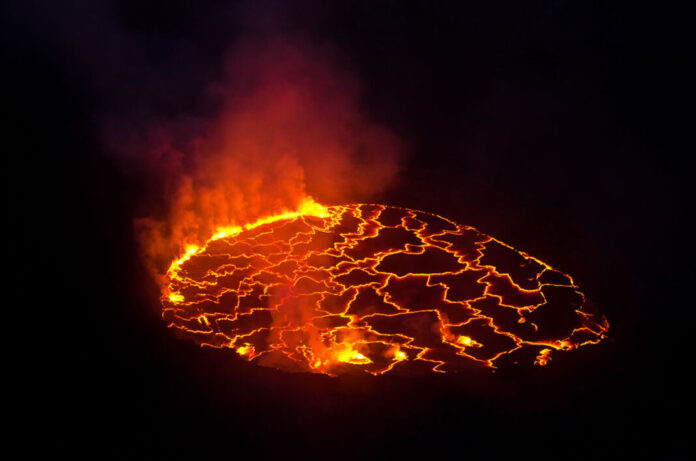
After hiking for five hours and waiting in a dark and chilly mist, Hilary Bradt is rewarded with an eyeful of Nyiragongo’s living breathing crater.
We slept almost under our volcano. At night our tent was canopied with an orange glow and in daylight Nyiragongo loomed over us, a perfect pyramid 3 470 metres high with a plume of smoke rising from its cone. Today we had arranged to take a closer look.
First we needed to sort out our food supplies. George said he’d see if he could buy eggs from the nearby village. Crowing cocks had kept him awake half the night, he said, so they must have hens and hens lay eggs. He trotted off while I packed up the tent, returning triumphant. ‘They didn’t understand my French,’ he said ‘so I flapped my arms and squawked like this.’ He squatted on the ground and gave a rather good imitation of a hen laying an egg. ‘So they said “Cuckoo?” and I shook my head and did more squawking. They just laughed and brought me these eggs.’ He pulled four small, dung-covered eggs from his pocket. ‘And I’ve learned that Swahili for hen is kukoo. Isn’t that sweet?’
It had been easy to organise the climb up Nyiragongo while we were in Goma. This was one of the few tourist attractions of eastern Zaïre in 1976. It cost only US$10 for a 24-hour trip to the crater with the services of a guide and a porter, plus shelter in one of the two huts just below the summit.
We set out in the early afternoon, following an easy trail through luxuriant vegetation which had, over the centuries, colonised the rivers of lava that had solidified on the side of the volcano like petrified tongues. Some were too new to support plant life, although a few ferns were bravely gaining a toe-hold in crevices. It took five hours to reach the hut where we spread out our sleeping bags, then rummaged in our packs to find a torch and snacks for the visit to the edge of the crater.
As we scrambled up the rocks a chill mist descended. Our guide walking ahead was a shadowy figure in the twilight. We reached the edge of the crater and saw nothing but mist. I was bitterly disappointed. Had we come all this way for an expanse of greyness? Our guide motioned to us to sit. We waited. With darkness came a slight breeze, and the mist started to break up. Soon we could see the sides of the crater, lit by a milky red glow. Then suddenly it was clear. We saw orange rivers of lava streaming down the sides of the cauldron to merge with bubbling red lakes. Scarlet fountains shot into the air. Black boulders hurtled up like footballs. Vapour swirled, hiding then revealing this unearthly scene. We couldn’t get enough of it! Most memorable views stay constant, but this was ever-changing, from black to red to orange and black again. The smell of the sulphur caught the back of our throats.
Our guide’s mutterings got louder and we realised we were cold and hungry. Time for the descent to the hut. Yes, we came back the next morning and peered over the edge of the crater. But the previous night’s drama when we glimpsed a biblical hell of fire and brimstone was missing.
We walked back to Goma.







